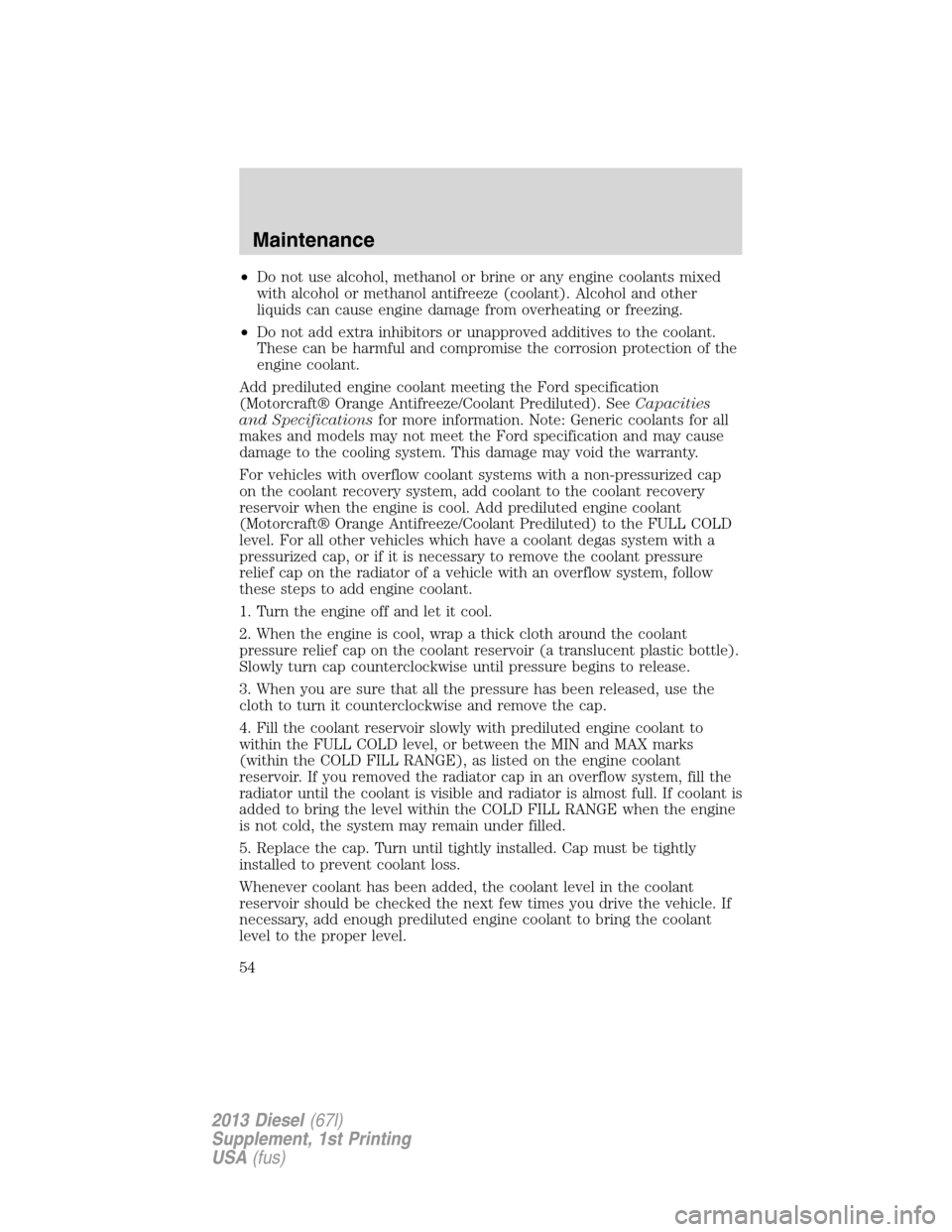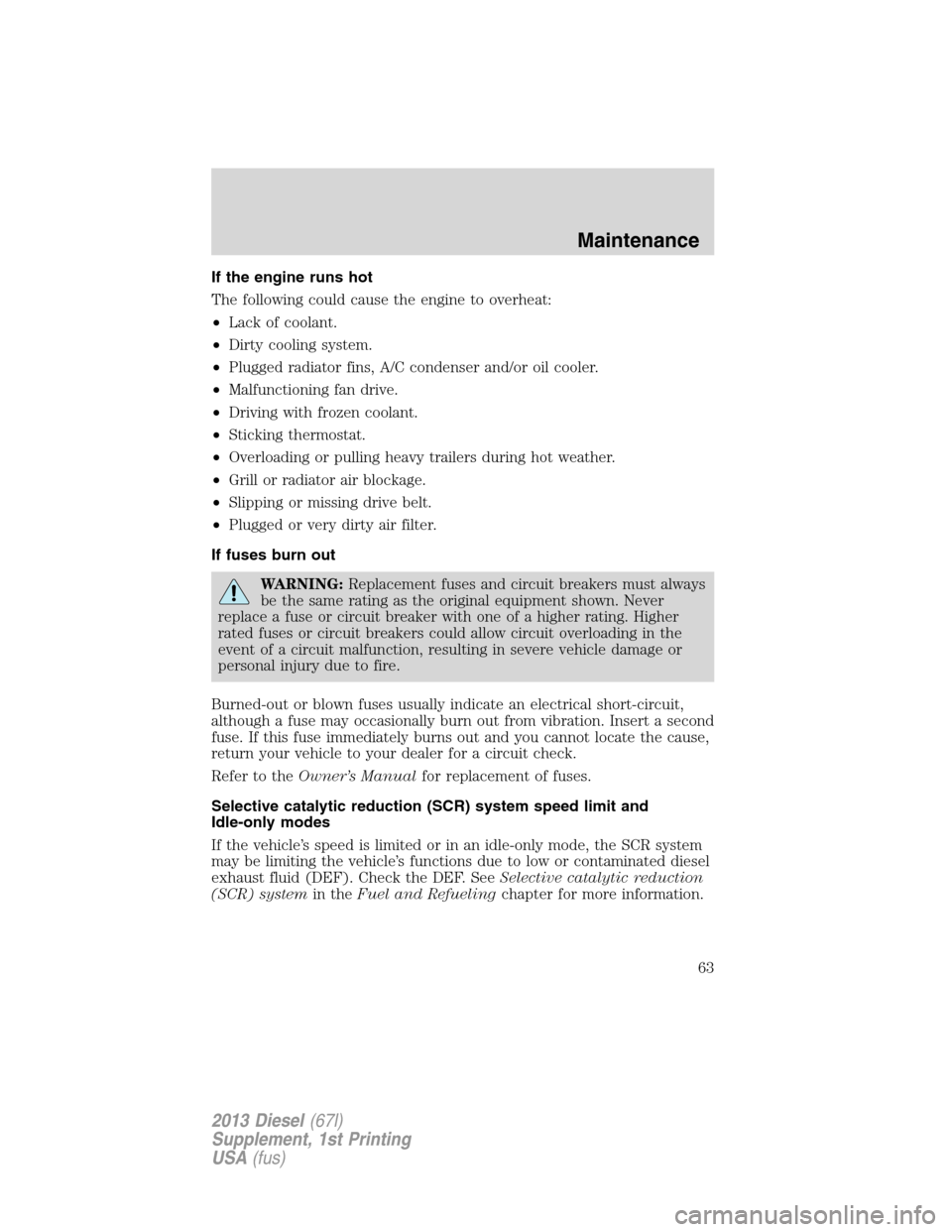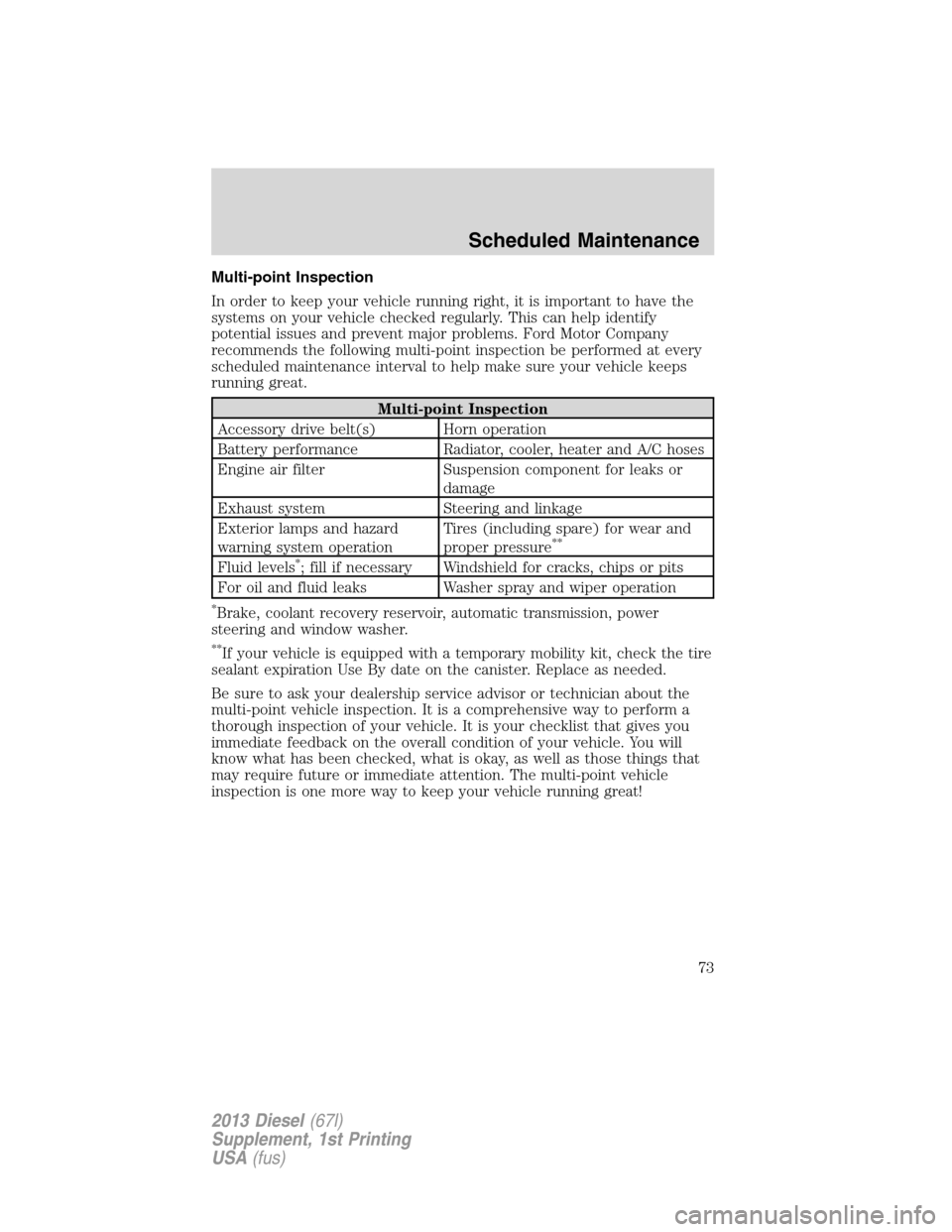2013 FORD SUPER DUTY radiator
[x] Cancel search: radiatorPage 55 of 95

•Do not use alcohol, methanol or brine or any engine coolants mixed
with alcohol or methanol antifreeze (coolant). Alcohol and other
liquids can cause engine damage from overheating or freezing.
•Do not add extra inhibitors or unapproved additives to the coolant.
These can be harmful and compromise the corrosion protection of the
engine coolant.
Add prediluted engine coolant meeting the Ford specification
(Motorcraft® Orange Antifreeze/Coolant Prediluted). SeeCapacities
and Specificationsfor more information. Note: Generic coolants for all
makes and models may not meet the Ford specification and may cause
damage to the cooling system. This damage may void the warranty.
For vehicles with overflow coolant systems with a non-pressurized cap
on the coolant recovery system, add coolant to the coolant recovery
reservoir when the engine is cool. Add prediluted engine coolant
(Motorcraft® Orange Antifreeze/Coolant Prediluted) to the FULL COLD
level. For all other vehicles which have a coolant degas system with a
pressurized cap, or if it is necessary to remove the coolant pressure
relief cap on the radiator of a vehicle with an overflow system, follow
these steps to add engine coolant.
1. Turn the engine off and let it cool.
2. When the engine is cool, wrap a thick cloth around the coolant
pressure relief cap on the coolant reservoir (a translucent plastic bottle).
Slowly turn cap counterclockwise until pressure begins to release.
3. When you are sure that all the pressure has been released, use the
cloth to turn it counterclockwise and remove the cap.
4. Fill the coolant reservoir slowly with prediluted engine coolant to
within the FULL COLD level, or between the MIN and MAX marks
(within the COLD FILL RANGE), as listed on the engine coolant
reservoir. If you removed the radiator cap in an overflow system, fill the
radiator until the coolant is visible and radiator is almost full. If coolant is
added to bring the level within the COLD FILL RANGE when the engine
is not cold, the system may remain under filled.
5. Replace the cap. Turn until tightly installed. Cap must be tightly
installed to prevent coolant loss.
Whenever coolant has been added, the coolant level in the coolant
reservoir should be checked the next few times you drive the vehicle. If
necessary, add enough prediluted engine coolant to bring the coolant
level to the proper level.
Maintenance
54
2013 Diesel(67l)
Supplement, 1st Printing
USA(fus)
Page 56 of 95

If you have to add more than 1.0 quart (1.0 liter) of engine coolant per
month, have your authorized dealer check the engine cooling system.
Your cooling system may have a leak. Operating an engine with a low level
of coolant can result in engine overheating and possible engine damage.
Engine and secondary cooling system refill procedure
The following procedure should be used when refilling the engine or
secondary cooling systems after it has been drained or become extremely
low.
1. Before you remove the cap, turn the engine off and let it cool.
2. When the engine is cool, wrap a thick cloth around the cap. Slowly
turn cap counterclockwise until pressure begins to release.
3. Step back while the pressure releases.
4. When you are sure that all the pressure has been released, use the
cloth to turn it counterclockwise and remove the cap.
5. Slowly add prediluted engine coolant to the coolant reservoir until the
coolant level is within the COLD FILL RANGE as listed on the reservoir.
6. Reinstall the pressure relief cap.
7. Start and run the engine at 2,000 rpm for 2 minutes.
8. Shut engine off, and remove the pressure relief cap as previously
outlined.
9. If required, add prediluted engine coolant to the coolant reservoir until
the coolant level is within the COLD FILL RANGE as listed on the
reservoir.
10. Engine cooling system: Repeat Step 5 until the coolant level has
stabilized (is no longer dropping after each step) AND the upper radiator
hose at the radiator is warm to the touch (indicating that the engine
thermostat is open and coolant is flowing through the radiator).
Secondary cooling system: Repeat Step 5 until the coolant level has
stabilized (is no longer dropping after each step) AND the lower
passenger side of the secondary radiator is warm to the touch
(indicating secondary thermostat is open and coolant is flowing
through the entire system).
11. Reinstall the pressure relief cap. Shut the engine off and let it cool.
12. Check the coolant level in the reservoir before you drive your vehicle
the next few times (with the engine cool).
Maintenance
55
2013 Diesel(67l)
Supplement, 1st Printing
USA(fus)
Page 64 of 95

If the engine runs hot
The following could cause the engine to overheat:
•Lack of coolant.
•Dirty cooling system.
•Plugged radiator fins, A/C condenser and/or oil cooler.
•Malfunctioning fan drive.
•Driving with frozen coolant.
•Sticking thermostat.
•Overloading or pulling heavy trailers during hot weather.
•Grill or radiator air blockage.
•Slipping or missing drive belt.
•Plugged or very dirty air filter.
If fuses burn out
WARNING:Replacement fuses and circuit breakers must always
be the same rating as the original equipment shown. Never
replace a fuse or circuit breaker with one of a higher rating. Higher
rated fuses or circuit breakers could allow circuit overloading in the
event of a circuit malfunction, resulting in severe vehicle damage or
personal injury due to fire.
Burned-out or blown fuses usually indicate an electrical short-circuit,
although a fuse may occasionally burn out from vibration. Insert a second
fuse. If this fuse immediately burns out and you cannot locate the cause,
return your vehicle to your dealer for a circuit check.
Refer to theOwner’s Manualfor replacement of fuses.
Selective catalytic reduction (SCR) system speed limit and
Idle-only modes
If the vehicle’s speed is limited or in an idle-only mode, the SCR system
may be limiting the vehicle’s functions due to low or contaminated diesel
exhaust fluid (DEF). Check the DEF. SeeSelective catalytic reduction
(SCR) systemin theFuel and Refuelingchapter for more information.
Maintenance
63
2013 Diesel(67l)
Supplement, 1st Printing
USA(fus)
Page 74 of 95

Multi-point Inspection
In order to keep your vehicle running right, it is important to have the
systems on your vehicle checked regularly. This can help identify
potential issues and prevent major problems. Ford Motor Company
recommends the following multi-point inspection be performed at every
scheduled maintenance interval to help make sure your vehicle keeps
running great.
Multi-point Inspection
Accessory drive belt(s) Horn operation
Battery performance Radiator, cooler, heater and A/C hoses
Engine air filter Suspension component for leaks or
damage
Exhaust system Steering and linkage
Exterior lamps and hazard
warning system operationTires (including spare) for wear and
proper pressure
**
Fluid levels*; fill if necessary Windshield for cracks, chips or pits
For oil and fluid leaks Washer spray and wiper operation
*Brake, coolant recovery reservoir, automatic transmission, power
steering and window washer.
**If your vehicle is equipped with a temporary mobility kit, check the tire
sealant expiration Use By date on the canister. Replace as needed.
Be sure to ask your dealership service advisor or technician about the
multi-point vehicle inspection. It is a comprehensive way to perform a
thorough inspection of your vehicle. It is your checklist that gives you
immediate feedback on the overall condition of your vehicle. You will
know what has been checked, what is okay, as well as those things that
may require future or immediate attention. The multi-point vehicle
inspection is one more way to keep your vehicle running great!
Scheduled Maintenance
73
2013 Diesel(67l)
Supplement, 1st Printing
USA(fus)